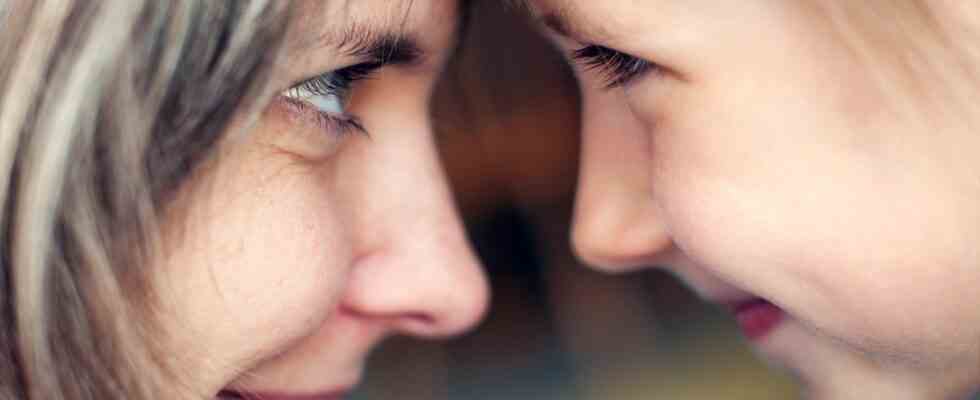non-verbal signals
“Look me in the eye”: How eye contact shapes our communication
Eye contact tells us a lot about our relationship with our counterpart.
© Imgorthand / Getty Images
When we meet someone, we look them in the eye. We do this automatically to classify our counterpart. Eye contact shapes our coexistence in many areas – and it reveals far more than we sometimes like.
When members of the South African Zulu tribe meet, they like to greet each other with a warm-hearted “Sawubona”. Translated it means something like “I see you”. And if you think about it carefully, this greeting hits the spot. What happens anywhere in the world when two people meet: They see each other. And they are usually the first to look at you.
Eye contact is one of the most meaningful and crucial gestures in our non-verbal communication. And whether we like it or not – when we come into contact with others, our eyes reveal a lot about how we feel about the other person. With good reason, when we first meet another person, we subconsciously focus on the eyes and the entire face.
Why we blink and look away
Glances serve us as orientation when it comes to assessing people and interpreting their behavior. At the same time, while we’re talking to other people, we’re automatically evaluating eye activity all the time. For example, two conversation partners unconsciously agree on who is speaking by looking at each other. Maybe you know that: Whoever makes a point looks at the person opposite and says non-verbally: “You may”.
However, not every eye play is as easy to interpret as the requesting look during a conversation. There are signals that often cause confusion. For example, if the listener blinks more, it is a sign of boredom, but if they stare at the other person, they may want to unsettle the speaker. On the other hand, if a person constantly avoids their own eyes, this is a sign of disinterest or insecurity.
mental health
Mental hygiene: These ten habits are balm for the soul
Yes, looks can tell us a lot. Our pupils in particular are honest messengers in this context. The behavioral researcher Irenäus Eibl-Eibelsfeldt was able to prove that our pupils automatically widen and our eyelids lift when we like someone. However, it also happens when we’re interested in the topic of conversation, when we’re sexually attracted to someone—and when we’re scared.
The perfect duration for eye contact
We have no control over how our pupils react to other people. But we can control how long we look the other person in the eye. According to British researcher Alan Johnston from University College London, this plays an important role in successful communication. In a study he therefore searched for the perfect gaze duration for the first contact. The result: one to three seconds at a time is optimal. Anything beyond that is potentially threatening, but a cursory glance is disinterested.
While looks may not necessarily kill, they do have a powerful effect on us. If someone is staring at us, then sit out loud scientists from the University of Freiburg a psychological resistance that can lead us to adopt a defensive attitude towards our interlocutor. At least that’s true of people who aren’t emotionally close.
On the other hand, you can look your partner, friends and family members in the eye more often. Because: How long we look at our counterpart says a lot about how much we like him. When we are in love, we like to look into the eyes of the chosen person for longer than three seconds with dilated pupils and lifted eyelids.
What looks trigger in the brain
It is quite possible that this intensive eye contact will then in turn have a positive effect on the feelings. The neurologist Knut Kampe from the University Hospital Hamburg-Eppendorf found out 20 years ago that our happiness center kicks in when someone we like looks in the eyes – or just find attractive.
Another person can therefore directly intervene in our feeling of happiness just by looking at us. But why is eye contact so important to us? Like so many non-verbal communication patterns, the search for eye contact is innate. Even babies seek eye contact with their mother to communicate and connect with her long before they can speak their first word. Several studies have also shown that our brain even has its own switching center that is exclusively responsible for evaluating eye contact. Clearly more communication takes place through our eyes than we realize.
Can you fall in love through eye contact?
Our looks tell who we like and when we’re bored, but can eye contact immediately lead to falling in love with another person? The US psychology professor Arthur Aron asked himself the question. So in a series of tests, he put together two strangers, had them answer 36 questions and then looked each other in the eyes in silence for four minutes. And: A few years later, the wedding bells actually rang for one of the couples.
Regardless of how meaningful the result of Aron’s study may be, it shows one thing: eye contact can lead to a deeper connection with our counterpart. This is also what the members of the Zulu tribe are all about with their greeting. They express that they accept and appreciate all facets of their counterpart. By the way, the usual reply is: “Shiboka”, which means something like: “Then I exist for you”.


